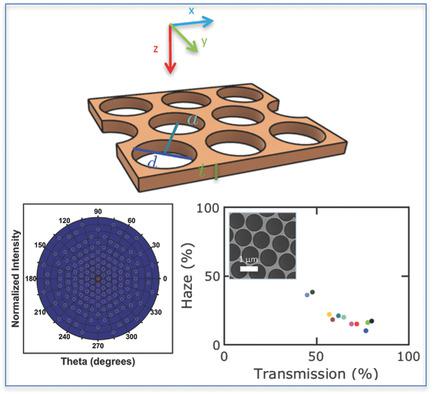当前位置:
X-MOL 学术
›
Adv. Opt. Mater.
›
论文详情
Our official English website, www.x-mol.net, welcomes your
feedback! (Note: you will need to create a separate account there.)
Fundamental Performance Limits and Haze Evaluation of Metal Nanomesh Transparent Conductors
Advanced Optical Materials ( IF 8.0 ) Pub Date : 2018-03-08 , DOI: 10.1002/adom.201700829 Tongchuan Gao 1 , Sajad Haghanifar 1 , Maxwell G. Lindsay 2 , Ping Lu 3 , Md Imrul Kayes 1 , Bradley D. Pafchek 2 , Ziyu Zhou 1 , Paul R. Ohodnicki 3 , Paul W. Leu 1
Advanced Optical Materials ( IF 8.0 ) Pub Date : 2018-03-08 , DOI: 10.1002/adom.201700829 Tongchuan Gao 1 , Sajad Haghanifar 1 , Maxwell G. Lindsay 2 , Ping Lu 3 , Md Imrul Kayes 1 , Bradley D. Pafchek 2 , Ziyu Zhou 1 , Paul R. Ohodnicki 3 , Paul W. Leu 1
Affiliation

|
Metal nanomeshes are demonstrated as flexible transparent conductors with performance comparable to indium tin oxide. However, it is not known what the performance limits of these structures are in terms of transparency and sheet resistance. More importantly, the haze, which describes how much incident light is scattered by these structures, has not been studied. In this paper, the transmission, sheet resistance, and haze of metal nanomeshes are comprehensively studied to determine their fundamental performance limits as transparent conductors through simulations and experiments. Numerical simulations and analytical calculations are used to evaluate the tradeoffs and correlations between these three figures of merit. A strong correlation is found between haze and transmission, where structures with high transmission tend to have low haze and vice versa. Structures with a pitch above 1000 nm are beneficial for achieving transmission over 80% and larger thickness is favorable in reducing sheet resistance without significantly affecting transmission. Furthermore, metal nanomeshes are fabricated to verify simulation results. The haze may be primarily explained by Fraunhofer diffraction, but the spectral dependence of haze requires analysis with Mie scattering theory. The results should apply to all metal grid or grating‐like structures. The fundamental performance limits evaluated here are helpful for guiding engineering design and research prioritization.
中文翻译:

金属纳米网透明导体的基本性能极限和雾度评估
金属纳米网被证明是具有与铟锡氧化物相当的性能的柔性透明导体。然而,就透明性和薄层电阻而言,这些结构的性能极限是什么还不知道。更重要的是,尚未研究雾度,雾度描述了这些结构散射了多少入射光。在本文中,对金属纳米网的透射率,薄层电阻和雾度进行了全面研究,以通过仿真和实验确定其作为透明导体的基本性能极限。数值模拟和分析计算用于评估这三个品质因数之间的权衡和相关性。发现雾度与传播之间存在很强的相关性,透射率高的结构往往雾度低,反之亦然。间距大于1000nm的结构有利于实现80%以上的透射率,而较大的厚度有利于减小薄层电阻而不显着影响透射率。此外,制造金属纳米网格以验证仿真结果。雾度可以主要通过弗劳恩霍夫衍射来解释,但是雾度的光谱依赖性需要使用米氏散射理论进行分析。结果应适用于所有金属网格或类似格栅的结构。此处评估的基本性能极限有助于指导工程设计和研究优先级。间距大于1000nm的结构有利于实现80%以上的透射率,而较大的厚度有利于减小薄层电阻而不显着影响透射率。此外,制造金属纳米网格以验证仿真结果。雾度可以主要通过弗劳恩霍夫衍射来解释,但是雾度的光谱依赖性需要使用米氏散射理论进行分析。结果应适用于所有金属网格或类似格栅的结构。此处评估的基本性能极限有助于指导工程设计和研究优先级。间距大于1000nm的结构有利于实现80%以上的透射率,而较大的厚度有利于减小薄层电阻而不显着影响透射率。此外,制造金属纳米网格以验证仿真结果。雾度可以主要通过弗劳恩霍夫衍射来解释,但是雾度的光谱依赖性需要使用米氏散射理论进行分析。结果应适用于所有金属网格或类似格栅的结构。此处评估的基本性能极限有助于指导工程设计和研究优先级。但是雾度的光谱依赖性需要使用Mie散射理论进行分析。结果应适用于所有金属网格或类似格栅的结构。此处评估的基本性能极限有助于指导工程设计和研究优先级。但是雾度的光谱依赖性需要使用Mie散射理论进行分析。结果应适用于所有金属网格或类似格栅的结构。此处评估的基本性能极限有助于指导工程设计和研究优先级。
更新日期:2018-03-08
中文翻译:

金属纳米网透明导体的基本性能极限和雾度评估
金属纳米网被证明是具有与铟锡氧化物相当的性能的柔性透明导体。然而,就透明性和薄层电阻而言,这些结构的性能极限是什么还不知道。更重要的是,尚未研究雾度,雾度描述了这些结构散射了多少入射光。在本文中,对金属纳米网的透射率,薄层电阻和雾度进行了全面研究,以通过仿真和实验确定其作为透明导体的基本性能极限。数值模拟和分析计算用于评估这三个品质因数之间的权衡和相关性。发现雾度与传播之间存在很强的相关性,透射率高的结构往往雾度低,反之亦然。间距大于1000nm的结构有利于实现80%以上的透射率,而较大的厚度有利于减小薄层电阻而不显着影响透射率。此外,制造金属纳米网格以验证仿真结果。雾度可以主要通过弗劳恩霍夫衍射来解释,但是雾度的光谱依赖性需要使用米氏散射理论进行分析。结果应适用于所有金属网格或类似格栅的结构。此处评估的基本性能极限有助于指导工程设计和研究优先级。间距大于1000nm的结构有利于实现80%以上的透射率,而较大的厚度有利于减小薄层电阻而不显着影响透射率。此外,制造金属纳米网格以验证仿真结果。雾度可以主要通过弗劳恩霍夫衍射来解释,但是雾度的光谱依赖性需要使用米氏散射理论进行分析。结果应适用于所有金属网格或类似格栅的结构。此处评估的基本性能极限有助于指导工程设计和研究优先级。间距大于1000nm的结构有利于实现80%以上的透射率,而较大的厚度有利于减小薄层电阻而不显着影响透射率。此外,制造金属纳米网格以验证仿真结果。雾度可以主要通过弗劳恩霍夫衍射来解释,但是雾度的光谱依赖性需要使用米氏散射理论进行分析。结果应适用于所有金属网格或类似格栅的结构。此处评估的基本性能极限有助于指导工程设计和研究优先级。但是雾度的光谱依赖性需要使用Mie散射理论进行分析。结果应适用于所有金属网格或类似格栅的结构。此处评估的基本性能极限有助于指导工程设计和研究优先级。但是雾度的光谱依赖性需要使用Mie散射理论进行分析。结果应适用于所有金属网格或类似格栅的结构。此处评估的基本性能极限有助于指导工程设计和研究优先级。










































 京公网安备 11010802027423号
京公网安备 11010802027423号